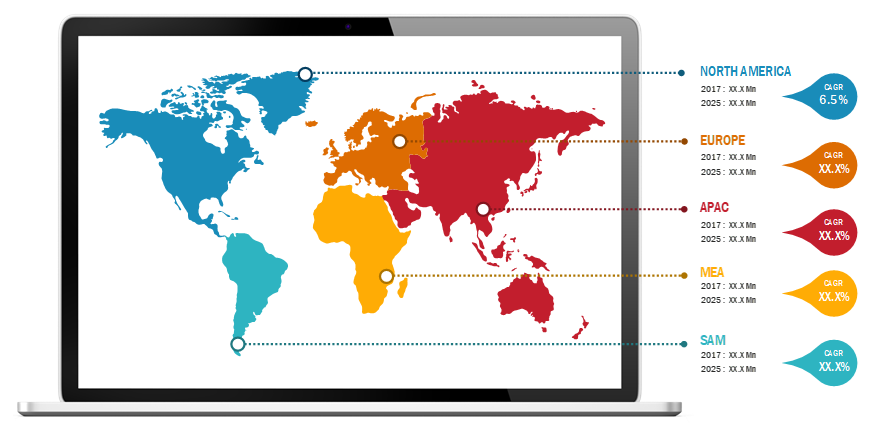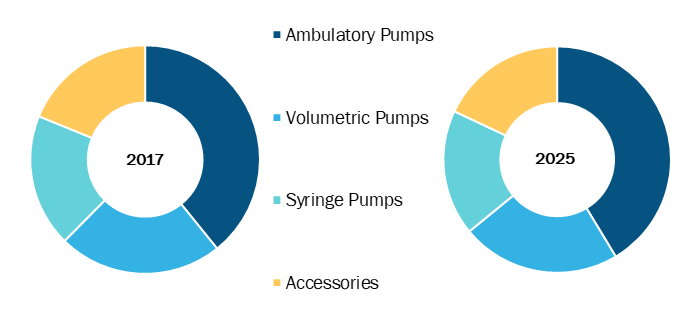The Infusion Pumps in healthcare market was valued at US$ 11,378.8 million in 2017 and it is projected to reach US$ 18,045.6 million by 2025; it is expected to grow at a CAGR of 6.2% from 2018 to 2025.
Infusion pump is a device used to deliver liquids into a patient’s body in a regulated manner, the pump enables to deliver fluid in large and small amounts. The pump is used to deliver both nutrients and medication in the patient’s body. Infusion pumps are regularly used to administer critical fluids, including high-risk medications, pump failures can have significant implications for patient safety. The growth of the Infusion Pumps in healthcare market is attributed to the increasing incidence of chronic diseases, increasing number of surgical procedures performed and growing geriatric population. However, the market is likely to experience restraining factors such as frequent product recalls of infusion pumps and stringent regulatory requirements.
The Infusion Pumps in healthcare market is expected to witness substantial growth post-pandemic. The Infusion Pumps in healthcare market is expected to witness substantial growth post-pandemic. The COVID-19 has affected economies and industries in various countries due to lockdowns, travel bans, and business shutdowns. The COVID-19 crisis has overburdened public health systems in many countries and highlighted the strong need for sustainable investment in health systems. As the COVID-19 pandemic progresses, the healthcare industry is expected to see a drop in growth. The life sciences segment thrives due to increased demand for invitro diagnostic products and rising research and development activities worldwide. However, the medical technologies and imaging segment is witnessing drop in sales due to a smaller number of surgeries being carried out and delayed or prolonged equipment procurement. Additionally, virtual consultations by healthcare professionals are expected to become the mainstream care delivery model post-pandemic. With telehealth transforming care delivery, digital health will continue to thrive in coming years. In addition, disrupted clinical trials and the subsequent delay in drug launches is also expected to pave the way for entirely virtual trials in the future. New technologies such as mRNA is expected to emerge and shift the pharmaceutical industry and market is also expected to witness more vertical integration and joint ventures in coming years.
Lucrative Regions for Infusion Pumps in Healthcare Market

- Sample PDF showcases the content structure and the nature of the information with qualitative and quantitative analysis.
- Sample PDF showcases the content structure and the nature of the information with qualitative and quantitative analysis.
Market Insights
Growing Applications of Infusion Pumps in Healthcare to Drive Infusion Pumps in Healthcare Market Growth
An infusion pump, a medical device delivers fluids, like nutrients and medications, into a patient's body in precise amounts. Infusion pumps are widely used in hospitals, nursing homes, and some types of infusion pumps can be used at home too. Infusion pumps are used to deliver medications – such as insulin or other hormones, antibiotics, chemotherapy drugs, and pain relievers. Thus rising prevalence of chronic diseases like cancer, diabetes and others drives the market growth.
Diabetes is one of the largest global health emergencies of the 21st century. Each year more and more people live with this condition, which can result in life-changing complications. According to the International Diabetes Federation (IDF), in 2017, number of people with diabetes in North America was approximately 46 million which is expected to grow at 62 million in 2045. The increase in the disease prevalence is around 35% during the forecast period.
Also, according to the World Health Organization in 2018, cancer was the second leading cause of death across the globe, and is responsible for an estimated 9.6 million deaths in 2018. Furthermore, the American Cancer Society estimated that in 2018, 1,735,350 new cancer cases were diagnosed in 2018.
Infusion pumps are also used to treat heart failure that helps in relieving and controlling the symptoms. According to Emory Healthcare in 2018, around 5 million people in America suffer from congestive heart failure (CHF).
Thus, the increasing incidences of chronic diseases poses several opportunities for the infusion pumps market to grow during the forecast period.
Infusion pumps are used during surgeries to send pain medicine through catheter to a specific part of your body. Infusion pumps can provide targeted and consistent medicine to decrease the pain. They are used when other methods are less effective or when the patient need long-term medicines or fluids.
The plastic surgical procedures like liposuction, abdominoplasty, and mammoplasty, require short hospital stay, patients are discharged for ambulatory recovery on oral analgesic management. However, anesthetists have started using infusion pumps to achieve adequate outpatient analgesic control. These pumps continuously administer and maintain constant plasma concentrations. According to the American Society of Plastic Surgeons in 2017, there were around 17.5 million surgical and minimally invasive plastic procedures performed in the United States.
Also, according to the Centers for Disease Control and Prevention (CDC) every year about 735,000 people in suffer from a heart attack. Furthermore, the Johns Hopkins University has estimated that approximately 84 million people in the US suffer from some form of the cardivascular disease. This has led to increase in cardiovascular surgeries.
Also, as per the survey “Estimate of the global volume of surgery in 2012: an assessment supporting improved health outcomes” 312 million major surgical procedures were performed in 2012, an increase of one-third from 2004. The number of surgical procedures are increasing whereas the number of deaths are decreasing.
Thus, increasing number of surgical procedures coupled with technological advancements is anticipated to drive the infusion pumps market.
Infusion pumps are widely used in geriatric population as it is an improved method to administer medication/ hormone/ nutrition and others. For instance, diabetes is a major cause of morbidity and mortality in ageing population that later largely attributable to various chronic complications. The number of ageing people with diabetes is increasing due to increased lifespan and the increased prevalence of diabetes in the geriatric population in the United States and worldwide. Infusion pump for diabetes provides more flexibility to the patient’s lifestyle while giving them greater control of the disease.
The elderly population is defined as group of people aged 65 and over. Population ageing is poised to become one of the most significant social transformations of the twenty-first century. According to the report of United Nations, in 2017, there were approximately 962 million people aged 60 or over across the globe, that consists of 13% of the global population. The population aged 60 or above is growing at a rate of about 3 per cent per year. Across the globe, the number of persons aged 80 or above is projected to triple by 2050. The approximate population is around 137 million in 2017 which will reach up to 425 million in 2050. The value is expected to increase to 909 million in 2100, around seven times its value in 2017.
The elderly people are more likely to have diabetes than younger people, and the effect of the disease on quality of life is particularly deep in this population. With increase in the number of geriatric population, the prevalence of the chronic diseases has increased. Therefore, the demand of infusion pumps products are expected to increase in the forecast period.
Type-Based Insights
In terms of type, the Infusion Pumps in healthcare market is segmented into ambulatory pumps, volumetric pumps, syringe pumps and accessories. In 2017, the volumetric pumps segment held a largest market share of 48.6% of the infusion pumps market, by type. The segment is anticipated to witness growth at a substantial rate of 6.4% during the forecast period.
Infusion Pumps in Healthcare Market, by Type – 2017 and 2025

- Sample PDF showcases the content structure and the nature of the information with qualitative and quantitative analysis.
- Sample PDF showcases the content structure and the nature of the information with qualitative and quantitative analysis.
Application-Based Insights
Based on application, the Infusion Pumps in healthcare market is segmented into diabetes, chemotherapy, gastrointestinal diseases and pediatrics. In 2017, the chemotherapy segment held a largest market share of 36.4% of the infusion pumps market, by application.
End User-Based Insights
In terms of end user, the Infusion Pumps in healthcare market is segmented into hospitals & clinics, ambulatory surgical centers and homecare. In 2017, the hospital segment held a largest market share of 45.5% of the infusion pumps market, by end user.
Customize Research To Suit Your Requirement
We can optimize and tailor the analysis and scope which is unmet through our standard offerings. This flexibility will help you gain the exact information needed for your business planning and decision making.
Infusion Pumps Market: Strategic Insights

Market Size Value in US$ 11,378.8 Million in 2017 Market Size Value by US$ 18,045.6 Million by 2025 Growth rate CAGR of 6.2% from 2018-2025 Forecast Period 2018-2025 Base Year 2018

Akshay
Have a question?
Akshay will walk you through a 15-minute call to present the report’s content and answer all queries if you have any.
 Speak to Analyst
Speak to Analyst
Customize Research To Suit Your Requirement
We can optimize and tailor the analysis and scope which is unmet through our standard offerings. This flexibility will help you gain the exact information needed for your business planning and decision making.
Infusion Pumps Market: Strategic Insights

| Market Size Value in | US$ 11,378.8 Million in 2017 |
| Market Size Value by | US$ 18,045.6 Million by 2025 |
| Growth rate | CAGR of 6.2% from 2018-2025 |
| Forecast Period | 2018-2025 |
| Base Year | 2018 |

Akshay
Have a question?
Akshay will walk you through a 15-minute call to present the report’s content and answer all queries if you have any.
 Speak to Analyst
Speak to Analyst
The Infusion Pumps in healthcare market players are adopting the product launch and expansion strategies to cater to changing customer demands worldwide, which also allows them to maintain their brand name globally.
Infusion Pumps in Healthcare Market – by Type
- Ambulatory Pumps
o Enteral Pumps
o Patient-Controlled Analgesia (PCA) Pumps
o Insulin Pumps
- Volumetric Pumps
O Smart Pumps
o Elastomeric Pumps
- Syringe Pumps
- Accessories
Infusion Pumps in Healthcare Market – by Application
- Diabetes
- Chemotherapy
- Gastrointestinal Diseases
- Pediatrics
Infusion Pumps in Healthcare Market – by End User
- Hospitals & Clinics
- Ambulatory Surgical Centers
- Homecare
Infusion Pumps in Healthcare Market – by Geography
North America
- US
- Canada
- Mexico
Europe
- France
- Germany
- Italy
- UK
- Spain
- Rest of Europe
Asia Pacific (APAC)
- China
- India
- South Korea
- Japan
- Australia
- Rest of APAC
Middle East & Africa (MEA)
- South Africa
- Saudi Arabia
- UAE
- Rest of MEA
South America and Central America (SCAM)
- Brazil
- Argentina
- Rest of SCAM
Company Profiles
- Becton Dickson and Company
- Terumo Corporation
- F. Hoffman-La Roche Ltd
- B. Braun Melsungen AG
- Medtronic, Baxter
- Smith Medical
- Moog Inc.
- ICU Medical, Inc.
- Insulet corporation

Report Coverage
Revenue forecast, Company Analysis, Industry landscape, Growth factors, and Trends

Segment Covered
Type , By Application and End User and Geography

Regional Scope
North America, Europe, Asia Pacific, Middle East & Africa, South & Central America

Country Scope
US, Canada, Mexico, UK, Germany, Spain, Italy, France, India, China, Japan, South Korea, Australia, UAE, Saudi Arabia, South Africa, Brazil, Argentina
- BD
- B. Braun Melsungen AG
- Terumo Corporation
- F. Hoffmann-La Roche Ltd.
- Medtronic
- Baxter International, Inc.
- Smith Medical
- Moog, Inc.
- ICU Medical, Inc.
- Insulet Corporation
The Insight Partners performs research in 4 major stages: Data Collection & Secondary Research, Primary Research, Data Analysis and Data Triangulation & Final Review.
- Data Collection and Secondary Research:
As a market research and consulting firm operating from a decade, we have published many reports and advised several clients across the globe. First step for any study will start with an assessment of currently available data and insights from existing reports. Further, historical and current market information is collected from Investor Presentations, Annual Reports, SEC Filings, etc., and other information related to company’s performance and market positioning are gathered from Paid Databases (Factiva, Hoovers, and Reuters) and various other publications available in public domain.
Several associations trade associates, technical forums, institutes, societies and organizations are accessed to gain technical as well as market related insights through their publications such as research papers, blogs and press releases related to the studies are referred to get cues about the market. Further, white papers, journals, magazines, and other news articles published in the last 3 years are scrutinized and analyzed to understand the current market trends.
- Primary Research:
The primarily interview analysis comprise of data obtained from industry participants interview and answers to survey questions gathered by in-house primary team.
For primary research, interviews are conducted with industry experts/CEOs/Marketing Managers/Sales Managers/VPs/Subject Matter Experts from both demand and supply side to get a 360-degree view of the market. The primary team conducts several interviews based on the complexity of the markets to understand the various market trends and dynamics which makes research more credible and precise.
A typical research interview fulfils the following functions:
- Provides first-hand information on the market size, market trends, growth trends, competitive landscape, and outlook
- Validates and strengthens in-house secondary research findings
- Develops the analysis team’s expertise and market understanding
Primary research involves email interactions and telephone interviews for each market, category, segment, and sub-segment across geographies. The participants who typically take part in such a process include, but are not limited to:
- Industry participants: VPs, business development managers, market intelligence managers and national sales managers
- Outside experts: Valuation experts, research analysts and key opinion leaders specializing in the electronics and semiconductor industry.
Below is the breakup of our primary respondents by company, designation, and region:

Once we receive the confirmation from primary research sources or primary respondents, we finalize the base year market estimation and forecast the data as per the macroeconomic and microeconomic factors assessed during data collection.
- Data Analysis:
Once data is validated through both secondary as well as primary respondents, we finalize the market estimations by hypothesis formulation and factor analysis at regional and country level.
- 3.1 Macro-Economic Factor Analysis:
We analyse macroeconomic indicators such the gross domestic product (GDP), increase in the demand for goods and services across industries, technological advancement, regional economic growth, governmental policies, the influence of COVID-19, PEST analysis, and other aspects. This analysis aids in setting benchmarks for various nations/regions and approximating market splits. Additionally, the general trend of the aforementioned components aid in determining the market's development possibilities.
- 3.2 Country Level Data:
Various factors that are especially aligned to the country are taken into account to determine the market size for a certain area and country, including the presence of vendors, such as headquarters and offices, the country's GDP, demand patterns, and industry growth. To comprehend the market dynamics for the nation, a number of growth variables, inhibitors, application areas, and current market trends are researched. The aforementioned elements aid in determining the country's overall market's growth potential.
- 3.3 Company Profile:
The “Table of Contents” is formulated by listing and analyzing more than 25 - 30 companies operating in the market ecosystem across geographies. However, we profile only 10 companies as a standard practice in our syndicate reports. These 10 companies comprise leading, emerging, and regional players. Nonetheless, our analysis is not restricted to the 10 listed companies, we also analyze other companies present in the market to develop a holistic view and understand the prevailing trends. The “Company Profiles” section in the report covers key facts, business description, products & services, financial information, SWOT analysis, and key developments. The financial information presented is extracted from the annual reports and official documents of the publicly listed companies. Upon collecting the information for the sections of respective companies, we verify them via various primary sources and then compile the data in respective company profiles. The company level information helps us in deriving the base number as well as in forecasting the market size.
- 3.4 Developing Base Number:
Aggregation of sales statistics (2020-2022) and macro-economic factor, and other secondary and primary research insights are utilized to arrive at base number and related market shares for 2022. The data gaps are identified in this step and relevant market data is analyzed, collected from paid primary interviews or databases. On finalizing the base year market size, forecasts are developed on the basis of macro-economic, industry and market growth factors and company level analysis.
- Data Triangulation and Final Review:
The market findings and base year market size calculations are validated from supply as well as demand side. Demand side validations are based on macro-economic factor analysis and benchmarks for respective regions and countries. In case of supply side validations, revenues of major companies are estimated (in case not available) based on industry benchmark, approximate number of employees, product portfolio, and primary interviews revenues are gathered. Further revenue from target product/service segment is assessed to avoid overshooting of market statistics. In case of heavy deviations between supply and demand side values, all thes steps are repeated to achieve synchronization.
We follow an iterative model, wherein we share our research findings with Subject Matter Experts (SME’s) and Key Opinion Leaders (KOLs) until consensus view of the market is not formulated – this model negates any drastic deviation in the opinions of experts. Only validated and universally acceptable research findings are quoted in our reports.
We have important check points that we use to validate our research findings – which we call – data triangulation, where we validate the information, we generate from secondary sources with primary interviews and then we re-validate with our internal data bases and Subject matter experts. This comprehensive model enables us to deliver high quality, reliable data in shortest possible time.
Trends and growth analysis reports related to Infusion Pumps Market

Jan 2019
Colonoscopes Market
Forecast to 2028 - COVID-19 Impact and Global Analysis By Product Type (Fiber Optic Colonoscopy Devices, Video Colonoscopy Devices); Application (Colorectal Cancer, Lynch Syndrome, Ulcerative Colitis, Crohn's Disease, Polyp); End User (Hospitals, Ambulatory Surgery Center, Others), and Geography

Jan 2019
Noninvasive Fat Reduction Market
Size and Forecast (2021 - 2031), Global and Regional Share, Trend, and Growth Opportunity Analysis Report Coverage: By Technology (Cryolipolysis, Laser Lipolysis, Ultrasound, and Others), End User (Hospitals, Dermatology Clinics & Cosmetic Clinics, and Others), and Geography (North America, Europe, Asia Pacific, Middle East & Africa, and South & Central America)

Jan 2019
Medical Ultrasound Flow Meter Market
Size and Forecast (2020 - 2030), Global and Regional Share, Trend, and Growth Opportunity Analysis Report Coverage: By Implementation Type (Clamp-On, Inline, and Others), Technology (Doppler, Transit Time, and Hybrid), Application (Heart and Lung Machines, Extracorporeal Membrane Oxygenation, Perfusion, Organ Transportation Systems, and Others), End User (Hospitals and Clinics, Ambulatory Surgical Centers, Research Laboratories, and Others), and Geography (North America, Europe, Asia Pacific, Middle East & Africa, and South & Central America)

Jan 2019
Rapid Test Kits Market
Size and Forecasts (2020 - 2030), Global and Regional Share, Trend, and Growth Opportunity Analysis Report Coverage: By Type (Rapid Antigen Testing, Rapid Antibody Testing, and Others), Product (Over-the-Counter Rapid Testing Kit and Professional Rapid Testing Kit), Technology (Lateral Flow Assay, Solid Phase, Agglutination, Immunospot Assay, and Cellular Component-Based), Application (Blood Glucose Testing, Infectious Disease Testing, Pregnancy and Fertility, Cardiometabolic Testing, and Others), End User (Hospital and Clinics, Home Care, Diagnostics Centers, and Others), and Geography (North America, Europe, Asia Pacific, Middle East & Africa, and South & Central America)

Jan 2019
Osteoarthritis Therapy Market
Size and Forecasts (2020 - 2030), Global and Regional Share, Trend, and Growth Opportunity Analysis Report Coverage: By Therapy Type [Transcutaneous Electrical Nerve Stimulation (TENS), Occupational Therapy, Physical Therapy, Platelet-Rich Plasma Therapy and Stromal Vascular Fraction, Prolotherapy, and Others], Disease Indication (Knee Osteoarthritis, Spine Osteoarthritis, Foot and Ankle Osteoarthritis, Shoulder Osteoarthritis, Hand Osteoarthritis, and Others), End User (Hospitals & Clinics, Specialty Clinics, Ambulatory Surgical Centers, Homecare, and Others), and Geography (North America, Europe, Asia Pacific, Middle East & Africa, and South & Central America)

Jan 2019
Bariatric Surgeries Market
Size and Forecasts (2020 - 2030), Global and Regional Share, Trends, and Growth Opportunity Analysis Report Coverage: By Type [Adjustable Gastric Bands (AGB), Sleeve Gastrectomy, Gastric Bypass, Biliopancreatic Diversion with Duodenal Switch (BPD-DS), and Others], End User (Hospitals and Ambulatory Surgical Centers), and Geography (North America, Europe, Asia Pacific, Middle East & Africa, and South & Central America)

Jan 2019
Post-Acute Care Market
Size and Forecasts (2020 - 2030), Global and Regional Share, Trends, and Growth Opportunity Analysis Report Coverage: By Service Type (Skilled Nursing Facilities, Inpatient Rehabilitation Facilities, Long-Term Care Hospitals, Home Health Agency, and Others), Age (Elderly, Adult, and Others), Disease Conditions (Amputations, Wound Management, Brain Injury and Spinal Cord Injury, Neurological Disorders, and Others), and Geography

Jan 2019
Lung Cancer Therapy Market
Size and Forecasts (2020 - 2030), Global and Regional Share, Trends, and Growth Opportunity Analysis Report Coverage: By Therapy Type (Noninvasive and Minimally Invasive), Indication (Non-Small Cell Lung Cancer and Small Cell Lung Cancer), End User (Hospitals, Oncology Clinics, Research Centers, and Others), and Geography (North America, Europe, Asia Pacific, South & Central America, and Middle East & Africa)